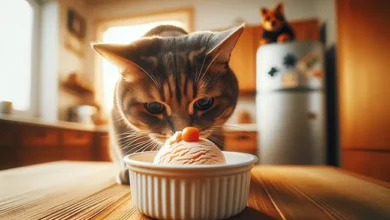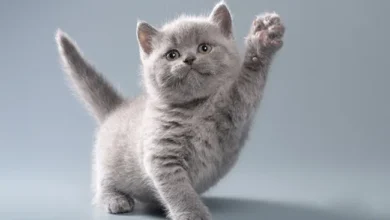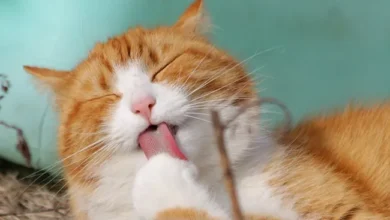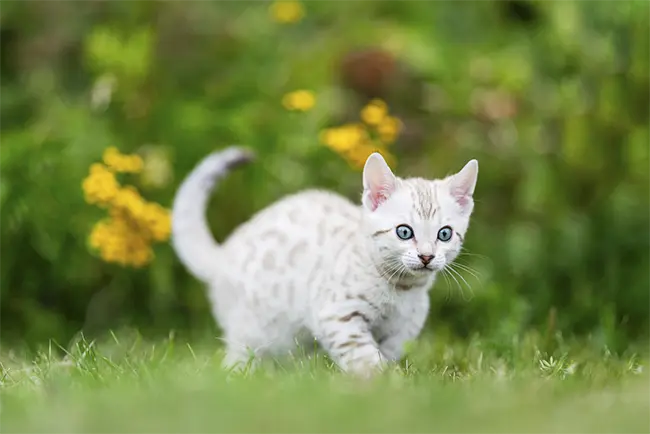
When selecting a pet, consider the adorable White Bengal Cats with their charming and stunning appearance. Their beautiful white coat will surely catch anyone’s eye, and their super affectionate and smart nature makes them fantastic pets. The White Bengal is a rare variant of the Bengal breed, originating from the wild Asian leopard cat, just like all domestic cats, but significantly different from their wild relatives or any other wild felines.
White Bengal Cats are also known as Snow Bengal Cats, referring to the color pattern of their coat, particularly the lighter coloration seen in the points (ears, face, legs, and tail) of the cat. This pattern is reminiscent of the Snow Leopard, a large cat species native to the mountains of Central and South Asia.
The Snow Bengal color pattern comes in three variations:
- 1. Seal Lynx Point: The points are a pale, creamy white and may have distinct markings.
- 2. Seal Mink: The points are slightly darker than Seal Lynx Point, with a hint of tan or beige.
- 3. Seal Sepia: The points are dark and can be very similar in color to the cat’s body, making the pattern less visible.
Snow Bengal Cats are highly sought after for their striking appearance, setting them apart from other Bengal color variations. The term “Snow Bengal” is often used to describe these cats, highlighting their connection to the stunning Snow Leopard and emphasizing their unique and alluring coat coloration.
Table of Contents
- Snow Bengal Cat History And Origin
- White Bengal Cat Appearance
- White Bengal Cat Size
- White Bengal Temperament and Personality Traits
- White Bengal Cat Diet
- Care and Health Considerations for Your White Bengal Cat
- Are Snow Bengal Cats Rare?
- How Much is a White Bengal Cat?
- Is The White Bengal Cat Right For You?
- Conclusion
Snow Bengal Cat History And Origin
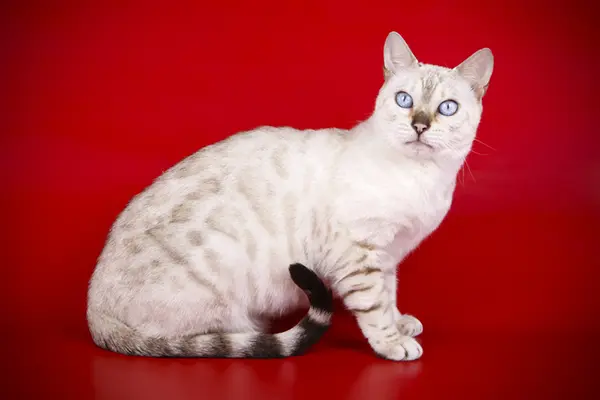
The Bengal cat breed originated in the United States during the 1970s through crossbreeding an Asian leopard cat with a domestic cat. This unique combination resulted in a captivating feline that retained the appearance of its wild ancestor while boasting a larger size and a temperament well-suited for domestic life. The journey of the Bengal’s creation can be traced back to 1963 when the first Bengal kitten was born to Jean Sudgen Mill. The initial breeding occurred between her short-haired domestic cat and a $150 Asian leopard cat purchased from a pet store.
Interestingly, the first hybrid kittens inherited their mother’s short hair, and no further breeding was conducted that year to establish the breed. However, in 1976, Mill successfully bred hybrids with longer coats, paving the way for the development of the Bengal breed through subsequent breeding programs.
As the Bengal breed progressed, it gained recognition and acclaim. In 1983, the International Cat Association (TICA) acknowledged White Bengals cats as an experimental breed fit for competition in shows and exhibitions. This recognition marked an important milestone for the breed’s development. With perseverance and dedication, Bengal cats attained Championship status by TICA in 1991 and ultimately gained full acceptance into TICA competitions in 1993.
Today, Bengal cats have rightfully claimed their place as one of the most popular and beloved feline companions, enchanting cat enthusiasts around the world with their striking appearance and engaging personalities.
White Bengal Cat Appearance
The White Bengal variety stands as a mesmerizing and uncommon type of Bengal cat. Typically adorned in pure white coats, some may sport subtle markings or exhibit near-total whiteness. This alluring appearance results from a color mutation that can manifest in any cat breed, including Bengals, dating back to the 1980s. However, it wasn’t until the late 1990s that documented cases of White Bengals came to light.
Distinctively, White Bengal cats are not classified as albinos since they lack pink eyes or noses and possess normal skin pigmentation. The captivating color variation is attributed to a recessive gene, requiring two carriers to come together during breeding to produce kittens displaying this striking coloring. Due to this genetic aspect, locating White Bengals can be more challenging compared to standard Bengals, as most breeders prioritize maximizing spotted and rosetted coloration in their litters. Nonetheless, with the emergence of several high-quality breeding lines dedicated to White Bengals, there is hope that this unique color variation will become increasingly prevalent in the future.
White Bengal Cat Size
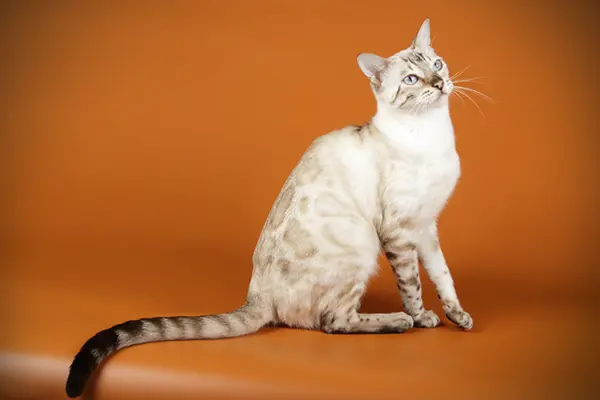
The White Bengal Cat is a breed known for its impressive and captivating size. These felines are generally larger than most domestic cat breeds, which contributes to their striking appearance. Their size is a result of their ancestry, as they are descendants of the wild Asian leopard cat.
On average, White Bengal Cats typically weigh between 8 to 15 pounds (3.6 to 6.8 kilograms) for females and 10 to 20 pounds (4.5 to 9 kilograms) for males. Their muscular build and robust frame give them a majestic and regal presence, setting them apart from other domestic cats.
The substantial size of the White Bengal Cat adds to its charm and allure, making them an extraordinary and eye-catching pet for cat enthusiasts. Their larger stature, combined with their striking white coat and often stunning blue eyes, make them a truly remarkable addition to any household.
White Bengal Temperament and Personality Traits
Encompassing the grace of a snow leopard and the gentle demeanor of a domestic cat, White Bengals emerge as a mesmerizing feline breed with intriguing characteristics.
On one hand, White Bengals exude an air of independence, embodying their predatory instincts with strength and agility. They are exceptional hunters, and their behaviors are profoundly influenced by these primal traits. It is essential to be cautious when keeping smaller pets around them, as Bengals may mistake them for prey.
On the other hand, their affectionate and sociable nature sets them apart. Constant interaction and bonding with their human companion play a vital role in their well-being. Neglecting this aspect may cause them to become restless and exhibit behaviors akin to their wild counterparts. However, early socialization and nurturing from kittenhood can transform them into devoted, loyal, and loving friends.
These endearing qualities render Bengals nearly ideal pets for families with young children, as they thrive in loving and lively environments.
Separation can be challenging for Bengals, as they form strong bonds with their owners. If the need arises to leave the cat in someone else’s care, it is best to entrust them to individuals familiar with the family. Otherwise, the cat may experience stress, refusal to eat, and even signs of depression.
Understanding the captivating blend of wild allure and affectionate companionship that White Bengals offer, responsible pet ownership and attentiveness are keys to fostering a rewarding relationship with these extraordinary felines.
White Bengal Cat Diet
The White Bengal Cat, like all domestic cats, has specific dietary needs to ensure its overall health and well-being. Providing a balanced and nutritious diet is essential for these beautiful felines to thrive and lead a healthy life.
As obligate carnivores, White Bengal Cats require a diet primarily composed of animal-based proteins. Their ancestors, the wild Asian leopard cats, primarily survived on a diet of small prey animals. To mimic this natural diet, it’s best to feed them high-quality commercial cat food that lists meat as the primary ingredient. Look for cat food that contains real meat, such as chicken, turkey, or fish, as these protein sources are vital for their muscle development and energy levels.
Avoid feeding your White Bengal Cat a diet primarily based on plant-based ingredients, as their bodies are not adapted to efficiently digesting carbohydrates. Foods high in fillers and grains should be avoided. Always check the cat food label and choose options that are free from artificial additives, preservatives, and excessive fillers.
Additionally, it’s essential to provide fresh and clean water at all times to keep your White Bengal well-hydrated. Cats can be prone to urinary tract issues, and proper hydration helps prevent such problems.
While some human foods are safe for cats in moderation, it’s crucial to avoid feeding them toxic foods like chocolate, onions, garlic, and certain artificial sweeteners (e.g., xylitol).
It’s recommended to consult with a veterinarian to determine the specific dietary needs of your White Bengal Cat based on its age, weight, activity level, and any individual health concerns. Regular veterinary check-ups and dietary adjustments as needed will ensure your feline friend enjoys a long and healthy life.
Care and Health Considerations for Your White Bengal Cat
Caring for a White Bengal Cat involves a combination of attention to their unique needs and providing a loving and safe environment. Here are some essential aspects of White Bengal Cat care and common health issues to watch out for:
- Grooming: The White Bengal Cat’s striking white coat requires regular grooming to keep it clean and free from tangles. Brush their fur at least once a week to remove loose hair and reduce shedding. Regular grooming also helps you monitor their overall health and detect any skin issues or abnormalities.
- Dental Care: Dental health is crucial for all cats, including White Bengals. Brush their teeth regularly to prevent dental problems like tartar buildup and gum disease. Providing dental treats or toys can also help maintain their oral hygiene.
- Exercise: White Bengal Cats are active and intelligent creatures that require regular play and exercise to stay happy and healthy. Engage them in interactive play sessions and provide toys and scratching posts to keep them mentally and physically stimulated.
- Litter Box Maintenance: Ensure the litter box is kept clean and odor-free. White Bengals, like all cats, are meticulous about their litter box hygiene, and a clean environment will encourage them to use it regularly.
- Nutrition: Provide a balanced and high-quality diet rich in animal-based proteins to meet their nutritional requirements. Avoid overfeeding to prevent obesity, which can lead to various health issues.
Common Health Issues
- Hypertrophic Cardiomyopathy (HCM): HCM is a heart disease that can affect White Bengal Cats and other breeds. Regular veterinary check-ups and early detection are crucial for managing this condition.
- Progressive Retinal Atrophy (PRA): PRA is a genetic eye disorder that can cause progressive vision loss. Responsible breeding practices can help reduce the risk of this condition.
- Patellar Luxation: White Bengals may be prone to patellar luxation, a condition where the kneecap slips out of its normal position. Regular exercise and maintaining a healthy weight can help reduce the risk of this issue.
- Dental Problems: Like all cats, White Bengals can suffer from dental issues such as periodontal disease. Regular dental care, including brushing their teeth, can help prevent such problems.
- Urinary Tract Issues: Cats, including White Bengals, can develop urinary tract problems, such as urinary crystals or infections. Ensuring they have access to fresh water and a balanced diet can help maintain good urinary health.
Regular veterinary check-ups, a balanced diet, a clean and stimulating environment, and lots of love and attention are the key ingredients for providing excellent care for your White Bengal Cat and ensuring they lead a happy and healthy life.
White Bengal Lifespan
The average lifespan of White Bengal Cats is similar to that of other domestic cat breeds. On average, White Bengals can live anywhere between 12 to 16 years, but with proper care, some may even surpass this range and live into their late teens or early twenties.
The lifespan of any cat can be influenced by various factors, including genetics, diet, exercise, environment, and access to healthcare. Responsible breeding practices, a balanced and nutritious diet, regular exercise, and regular veterinary check-ups are essential in promoting a long and healthy life for White Bengal Cats.
Are Snow Bengal Cats Rare?
Yes, Snow Bengal Cats are quite rare and special because of their unique coat color. While regular brown Bengals have been around for a long time, Snow Bengals only started being bred in the late 1990s and early 2000s.
Because they are not as common as the regular brown Bengals, it might be a bit hard to find them. If you really want to have a Snow Bengal, you’ll need to do some research and be patient in your search. But it’ll be worth it because they look so amazing, with their coat resembling the beautiful Snow Leopard.
If you decide to get a Snow Bengal, make sure to find a good breeder who takes good care of their cats. Taking care of a Snow Bengal can be a wonderful and rewarding experience, as they are truly special and unique companions.
How Much is a White Bengal Cat?
The price of a Bengal cat can vary based on several factors, including its color variation and the reputation of the breeder. Specifically, for a White Bengal kitten, you can generally expect to pay anywhere from $3,000 to $5,000 USD. However, prices may differ for other Bengal color patterns and rare variations, such as the Snow Mink.
When searching for a breeder to purchase a Bengal cat, it’s essential to conduct thorough research and choose a reputable one with a good track record. Unfortunately, there are some unscrupulous breeders who prioritize profit over the well-being of their cats.
Keep in mind that the initial cost of acquiring a Bengal cat is just the beginning of the financial commitment. Owning a cat involves ongoing expenses like food, grooming, veterinary care, and other necessities. Being prepared for the long-term financial responsibility of pet ownership is crucial.
Remember, by investing time in finding a reputable breeder and considering all aspects of pet ownership, you can ensure a joyful and rewarding experience with your Bengal cat.
Is The White Bengal Cat Right For You?
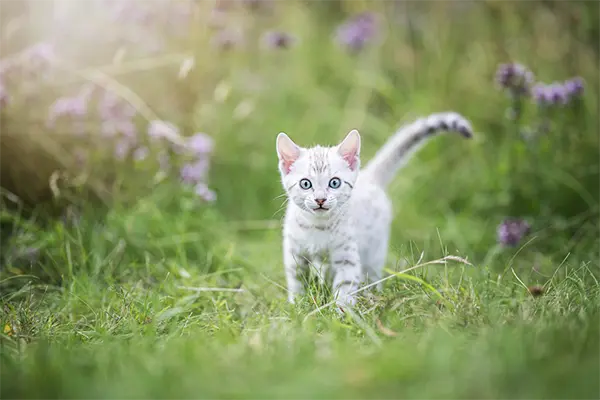
Is a Bengal Cat the right choice for you? Making this decision requires careful consideration of your lifestyle and commitment to pet ownership. Bengal cats are not suitable for everyone due to their unique traits. They are highly energetic, intelligent, and mischievous, demanding plenty of playtime and attention to prevent destructive behavior. Therefore, they are best suited for individuals who can dedicate ample time and effort to their feline companion.
Moreover, Bengal cats can be more expensive than other domestic breeds. Even for non-pedigree kittens from reputable breeders, you should expect to pay at least $1,000. This financial investment should be factored into your decision-making process.
Regarding the White Bengal cat, it is essential to note that it is not a distinct breed but rather a variation of the Bengal cat. Some breeders have reintroduced domestic cats (F4 and beyond) into the breeding process to tame their wild looks and temperament.
While White Bengal cats boast a captivating appearance, they may inherit some of the feisty traits from their Bengal ancestors. Successfully domesticating and training them requires considerable knowledge and financial resources.
In conclusion, if you possess the time, energy, and financial capability to meet the unique needs of a Bengal cat, they can make wonderful and fascinating pets. However, due to their specific requirements and characteristics, Bengal cats are best suited to responsible owners who can provide the attention and commitment these extraordinary felines deserve.
Conclusion
In conclusion, White Bengal cats represent a captivating and rare variation of the Bengal breed. With their stunning resemblance to snow leopards and their unique coloration, they undoubtedly stand out among feline enthusiasts. However, prospective owners must be aware of the responsibilities that come with owning a White Bengal.
These magnificent felines are not for everyone; their high-energy, mischievous nature demands
dedicated attention and playtime. Those who can devote ample time and effort to their care will find rewarding companionship in these intelligent and affectionate cats.
While White Bengal cats can be more expensive than other domestic breeds, their allure and uniqueness make them worth the investment for enthusiasts seeking a special feline companion. However, it is crucial to find reputable breeders who prioritize the health and well-being of their cats.
Domesticating and training White Bengals may pose challenges, given their ancestral temperament. Yet, with the right knowledge and resources, a strong bond can be developed, making them loyal and loving friends.
In the end, White Bengal cats offer an extraordinary and unforgettable pet ownership experience for those willing to embrace their distinctiveness and provide the love and care they deserve. For the right owner, a White Bengal cat can become a cherished and majestic addition to the family, creating cherished memories for years to come.

